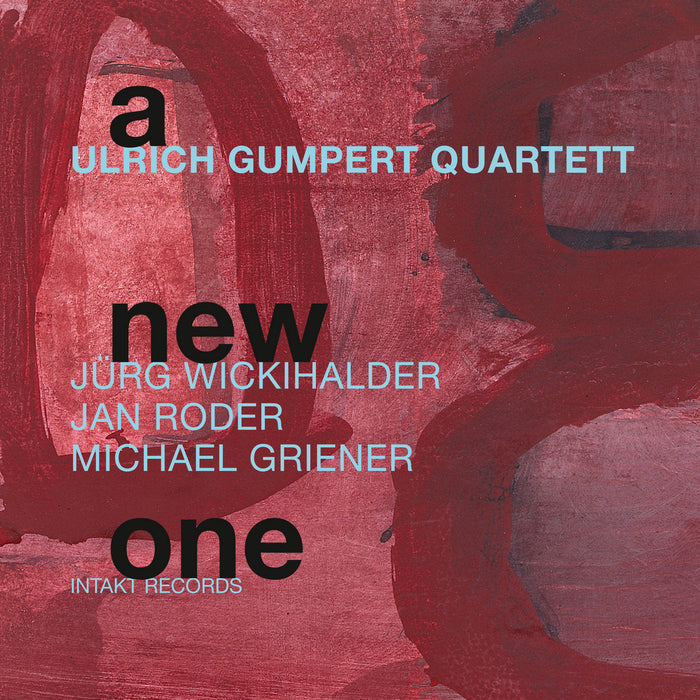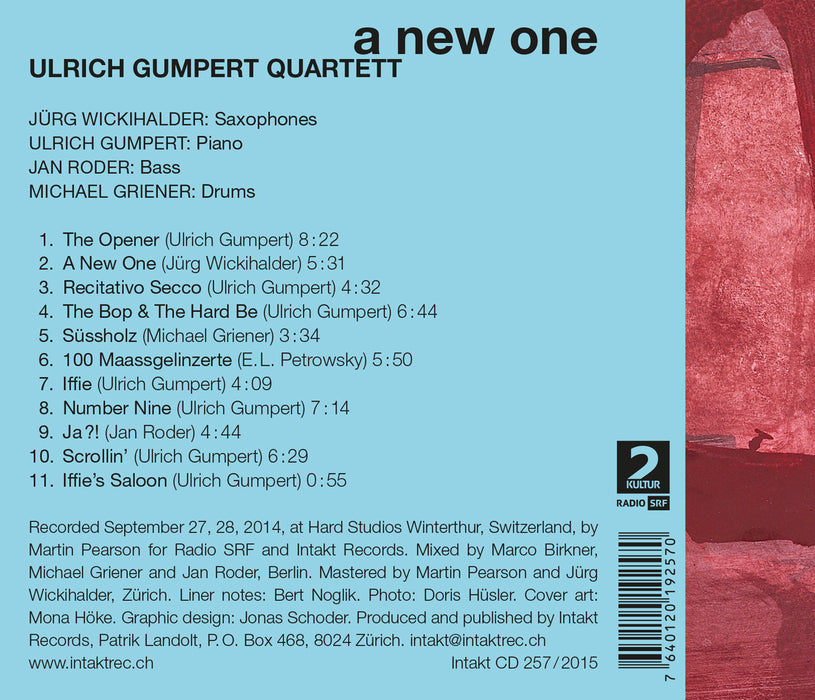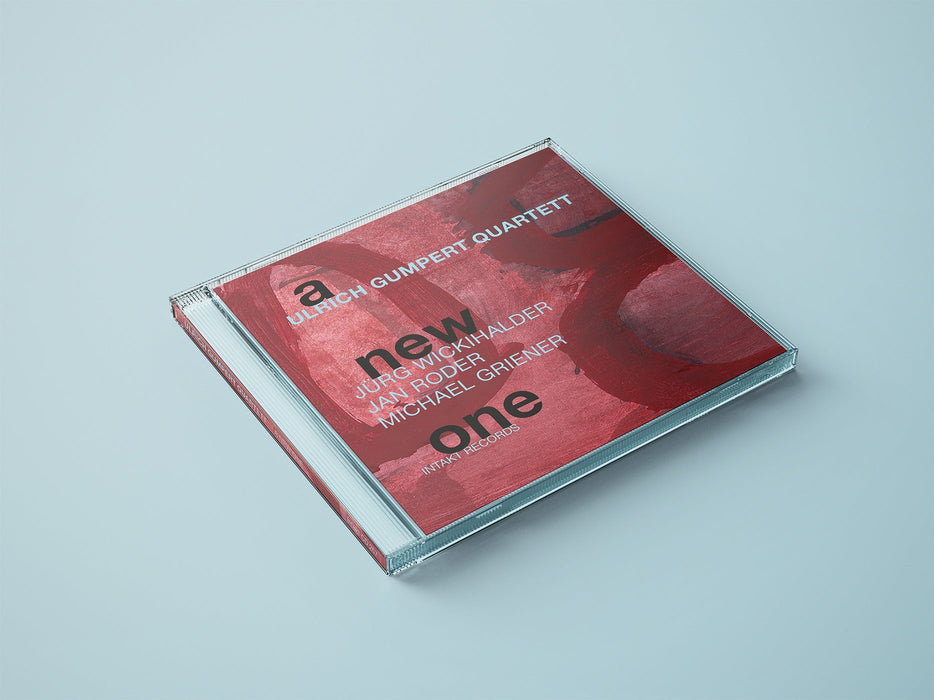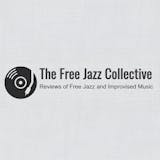


257: ULRICH GUMPERT QUARTETT. A New One
Intakt Recording #257/ 2015
Jürg Wickihalder: Saxophones
Ulrich Gumpert: Piano
Jan Roder: Bass
Michael Griener: Drums
More Info
Willkommen in Ulrich Gumperts Welt - in einer Welt mit verborgenen Schönheiten, kleinen Kostbarkeiten und skurrilen Erfindungen. Diese Welt wird vorangetrieben vom rhythmischen Drive, gelegentlich unterbrochen durch kurzes Innehalten, nur kurz aufgelöst ins Klangliche oder Geräuschhafte, dann wieder rollend, auf dass es immer so weiterginge ... Gumpert präsentiert die zweite Platte seines eigenen Quartetts, seit 2005 spielt er mit der Band, nach dem Saxophonisten Ben Abarbanel-Wolff stiess vorübergehend Ken Vandermark dazu. Nun hat Gumpert zur kongenialen Rhythmus-Gruppe mit Jan Roder und Michael Griener den passenden Bläser gefunden: den Zürcher Musiker Jürg Wickihalder. A New One. Der Jazzkritiker Bert Noglik schreibt in den Liner notes zu Gumperts Quartett: „Die schwebende Eleganz von Steve Lacy, die genial vertrackte Logik von Monk, das Erdige und die Tiefe von Mingus, die Freiheiten von Ornette, das Erhabene und das Hymnische von Coltrane - all das spielt hier hinein."
Album Credits
Cover art: Mona Höke
Graphic design: Jonas Schoder
Liner notes: Bert Noglik
Photo: Sandro Bettinaglio
Recorded September 27, 28, 2014, at Hard Studios Winterthur, Switzerland by Martin Pearson for Radio SRF and Intakt Records. Mixed by Marco Birkner, Michael Griener and Jan Roder Berlin. Mastered by Martin Pearson and Jur̈g Wickihalder, Zur̈ich.
Neben seinen famosen Großformationen hat Ulrich Gumpert stets auch kleinere Formate wie Duos oder das Quartett gepflegt. Letzteres hat der Berliner Pianist, 2005 mit dem Deutschen Jazzpreis geehrt, im selben Jahr ins Leben gerufen. Für das zweite Album hat er nun einen neuen Saxophonisten ins Boot geholt. Der Zürcher Jürg Wickihalder, der vor Jahren einmal im Duo mit Gumpert zu hören war, macht seine Sache ausgezeichnet. Im hymnischen Eröffnungsstück leuchtet er auf dem Bariton (?) Ecken und Kanten der Gumpert-Komposition aus. Der Pianist selbst gibt sich überraschend zurückhaltend, nur selten gleitet er in Monk'scher-Manier über die Tastatur. In der Ballade „Recitativo secco" setzt er „trocken" Ton an Ton um zur typischen Melodik und Rhythmik (Schlagzeug: Michael Griener) seiner Stücke überzuführen, hier zu „The Bop & The Hard Be". Das fröhlich hüpfende Iffie's Saloon" erweckt in weniger als einer Minute abschlie- Bende Heiterkeit. Die acht Stücke des knapp 70-Jährigen (drei weitere haben Jürg Wickihalder, Bassist Jan Roder und Langzeit-Gefährte Ernst-Ludwig Petrowsky beigesteuert) sind ansonsten von eindringlicher Stringenz und halten die Waage zwischen Swing und Free. „Es swingt wie verrückt und es ist frei wie verrückt", merkte der Pianist lakonisch angesichts dieser Aufnahmen an.
n a rather disparaging comment about Switzerland, Orson Wells once said that the only thing that the country had contributed to world history was the wrist watch. Wells was not known for hyperbole but then he was not known to be as discerning about music as he should have been. Not as discerning as Intakt Records or Switzerland’s elder imprint, hatHUT. Too bad he did not live to see these entities rise to eminence today. It is fair to say that Intakt is a boutique label; small in size and the number of releases, perhaps, but big on musical and production quality which is the next best thing to the quality of artistry within Intakt’s portfolio.
Recent releases feature recordings by Tom Rainey with Ingrid Laubrock and Mary Halvorson, Ali Keïta with Jan Galega Brönnimann and Lucas Niggli, Sarah Buechi with Stefan Aeby, André Pousaz and Lionel Friedli, the Ulrich Gumpert Quartett featuring Gumpert, Jurg Wickihalder, Jan Roder and Michael Greiner, Florian Egli with Dave Gisler, Martina Berther and Rico Baumann and the great Pierre Favre together with Chris Jaeger, Markus Lauterburg and Valeria Zangger. This is a masterfully put-together roster with the very finest of European and American artists playing music that reaches inebriating heights. Drunk with this artistry it is not possible to come down to earth especially if you listen to one record after the other, as I did, which reminds me of the time I met Elvin Jones after a long session testing Zidjian cymbals. A head full of sound is putting it mildly. And yet, I cannot think of a better or easier way to choke myself with gold. Not now; not ever…
This recording takes its cues from the chopped rhythms and angular melodies encountered in a realm where Thelonious Monk and Cecil Taylor meet. But whichever extremity to choose to look at it from the experience is equally rewarding. The delicate – admittedly nebulous – balance between keeping your steely distance while employing a touch that can move the erotic into fetishising the relationship between fingers that caress keys – in other words the hallmark of good piano playing is in evidence all over this recording. The shape-shifting pulse, at times nudging the rhythmic flow towards the asymmetrical, the playing mighty overt is delightfully clandestine. The best part of this approach is that it enables the musicians to launch into the pieces proper and pursue a deliberate rock-steady course that at first seems obsessively literal (those slightly precious staccato chords), yet the carefully built climaxes and increasing variety in character generate assiduous momentum. In this context the rapid scales of ‘The Bop & The Hard Be’ and hurling central minor-key section are surprisingly bracing and angular, forgoing the rippling poise that the players bring to this particular piece.
Superlative improvised music seems almost in abundance these days and it is sometimes hard to tell players apart. But this group is distinctive. For my ears the Ulrich Gumpert Quartett brings everything home in a way that is deeply personal, vivid and unique. No one who loves contemporary music or exquisite piano-playing for that matter will want to miss this one.
https://jazzdagama.com/music/intakt-tom-rainey-pierre-favre/
Andare in profondità con gli strumenti della leggerezza e dello spiazzamento ironico. Queste le prerogative di Ulrich Gumpert, storico esponente della scena creativa europea, che negli anni Settanta fu cofondatore del quartetto Synopsis insieme a Konrad Bauer, Ernst-Ludwig Petrowsky e Gunter Baby Sommer, tra le cui realizzazioni c'è un album dal titolo che susciterebbe immensa invidia in ogni dadaista: Auf der Elbe schwimmt ein rosa Krokodil (nel fiume Elba nuota un coccodrillo rosa).
Sulla scena europea, Gumpert si collocava in una via di mezzo tra Alexander von Schlippenbach e l'olandese Misha Mengelberg, tra le influenze di Cecil Taylor e Thelonious Monk. Ma il pianista di Jena si ritagliò una propria dimensione autonoma, nella quale era importante l'apporto della musica tradizionale e popolare germanica e la sua elaborazione in chiave sottilmente ironica, dissacrante e teatrale. Significativi sono in tal senso i frequenti duetti con Sommer. Molti ricordano Gumpert pure per la collaborazione in duo con Steve Lacy, da cui scaturì l'album Deadline. Un contesto dove spicca la preparazione accademica del pianista, che tra l'altro si è cimentato in modo eccellente con la musica di Satie.
Questo A New One si aggiunge alla documentazione che l'etichetta Intakt rivolge da tempo al lavoro di Gumpert, sia con il Zentral Quartett che nel duo con Sommer. Ma l'ultima realizzazione in quartetto per l'etichetta svizzera, con la stessa ritmica che compare qui e con un altro sassofonista, Ben Abarbanel-Wolff, risaliva al 2006. Nove anni dopo arriva questo CD che s'impone all'attenzione per la forza creativa e il lirismo di cui è pregno.
In primo luogo nel disco prende evidenza in modo perfetto una delle prerogative di Gumpert: la dissimulazione. Requisito che il pianista modella con qualità istrioniche, da consumato attore. Il brano che apre A New One ne è l'esempio lampante. Dopo un'introduzione di sapore coltraniano, dove però le note del pianoforte sdrammatizzano la tensione, sembra prendere forma un tema leggero, di stampo hard-bop. Ed ecco che, dal procedere sghembo del tema fino agli assoli, tutto imbocca direzioni inusuali, si affaccia sulla libertà completa, torna a ricomporsi.
In questo gioco di dissimulazione e spiazzamento, la sezione ritmica, formata da una coppia di consumati collaboratori di Gumpert, procede imperturbabile e ricca di elasticità, di respiro e varietà timbrica. Chi emerge con forza e originalità, accanto al leader, è il giovane sassofonista Jürg Wickihalder, che presenta una bella voce scura al tenore, mentre al soprano dichiara apertamente la sua ascendenza da Lacy. Il suo brano che dà il titolo all'album ne è un bell'esempio, insieme a "100 Maassgelinzerte," di Petrowsky.
Tra gli undici pezzi, sette sono di Gumpert, e mostrano una ricca varietà di ispirazione: dal severo, notturno "Recitativo Secco," dove è proprio il pianoforte a ritagliarsi un episodio delizioso, a "The Bop & The Hard Be," dove ancora la dissimulazione stilistica e la vicinanza al genio di Monk tracciano il percorso. Fino al sigillo conclusivo di "Iffie's Saloon": fulminante sberleffo di un attore consumato, che sembra fare il verso a Buster Keaton. Preziose le note di copertina di Bert Noglik.
https://www.allaboutjazz.com/a-new-one-ulrich-gumpert-intakt-records-review-by-giuseppe-segala
Attacco in deciso stile old-school, come poi si paleserà l’articolata sequenza di A New One, che non cela il suo gusto per la dissonanza sapiente e l’iconoclastia costruttiva, insomma quei tópoi complessi ma già familiari che di primo acchitto rimanderebbero all’ispirativa figura di Thelonious Monk.
Ma vi è di più – potendovi a varie riprese scorgere non soltanto l’ombra del di lui seguace Steve Lacy, o dei diversamente bellicosi confratelli Max Roach o Charles Mingus e insomma, se non d’ampiezza enciclopedica almeno in forma trasversale, l’album è un tour de force che sviluppa con inventiva composizioni ripartite tra i quattro ma fortemente imbevute delle enormi firme patriarcali (non manca chi addirittura lo definisce “Il miglior album di Monk – che non ha mai realizzato”).
Sequenza di grande inventiva, e non minore agio nel declinare, riargomentandole, le morfologie di quella lungimirante Age of Transition, infuse di energica fiamma e pervasiva tensione, amministrando in libertà le disseminate “oddities” e le tinte “freaky” di tanti ispirativi Numi.
Il redivivo quartetto (non solo discograficamente) riprende il discorso dal precedente, omonimo album (Intakt, 2007) avvicendando al ruolo sassofonistico un sempre più eloquente e tonico Jürg Wickihalder, pervaso da coltraniane grinta e visionarietà, laddove sono sapientemente esauditi i ruoli di del ligneo drumming di Michael Griener e del sostegno a note basse di Jan Roder, naturalmente non omettendo la prestazione maiuscola, raramente defilata ma di naturale, torrenziale, a tratti scintillante inventiva, con padronanza magistrale di più linguaggi – insomma una riconferma e non una ripetizione per un Maestro d’architetture e idiomi in jazz e una salda affermazione per un combo motivato e funzionale.
https://www.jazzconvention.net/2016/04/03/ulrich-gumpert-quartet-a-new-one/
East Germany’s most prominent jazz composer/pianist, Ulrich Gumpert, 70, shows that he has lost none of his Teutonic-Thelonious acuity in the quarter century since the destruction of the Berlin Wall. With band members several years his junior, including Germans, bassist Jan Roder and drummer Michael Griener, plus Swiss saxophonist Jürg Wickihalder, the quartet moves through 11 mostly Gumpert-composed tunes that could equally impress in a West Berlin club with aficionados familiar with the sounds of Monk and bop, as well as an East Berlin theatre audience more attuned to Socialist Realist anthems and folkloric marches.
One instance of this is Iffie, initially a balladic theme the pianist developed years ago for a performance with a poet, resolved with a snorting Wickihalder solo into 100 percent contemporary jazz. Recitativo Secco, is a plaintive Germanic recitation for full band that too is transformed into a jokey promenade with cymbal sizzles and reed smears. There’s also the Griener-composed Süshotz, a simple rustic tune that balances Mozartian rococo with a charming alto saxophone lead. With Wickihalder playing tenor saxophone, Number Nine and the give-away titled The Bop & The Hard Be are more overtly Monkish, with the pianist replicating Monk’s hesitant yet spiky chording on the second, as Roder walks and the saxophonist channels Johnny Griffin’s bite and speed. Expanding and contracting time as it develops, Number Nine shuffles as much as it swings with Gumpert introducing ragtime and boogie-woogie motifs that lock in with Wickihalder reed outbursts that are as hard and thick as titanium.
Like a pseudo-military march the penultimate Scrollin’ is driven by a tough drum solo, moderated by elegant string reverberations from Roder, ending in a formation that finds each musician hopscotching and circling around the others as he solos. Confirming that sardonic humour wasn’t stifled in the German Democratic Republic (GDR), the CD ends with a 55-second reprise of Iffie called Iffie’s Saloon, with appropriate barroom-like plinking from Gumpert and nasal soprano saxophone passages from Wickihalder. In spite of its misdeeds, the GDR allowed talents like Gumpert to flourish; luckily A New One gives us in the West a new way to experience it.
https://www.thewholenote.com/index.php/newsroom/musical-life/remembering/25968-a-new-one-ulrich-gumpert-quartet
For the past decade, Ulrich Gumpert has led quartets featuring Roder and Griener, with different saxophonists – currently Jürg Wickihalder. On 'A New One', the leader contributes seven compositions out of eleven, with others by Wickihalder, Griener and Roder. Gumpert is a student of jazz history whose collection of recordings covers all eras, and his compositions show a similar catholic taste, glossing over stylistic boundaries from New Orleans to free jazz. His own piano style revolves very effectively round a hard/postbop axis, with reminiscences of Cecil Taylor and Andrew Hill.
He rightly says of this quartet, "It swings like **** and it's free like ****". The rousing opening track, Gumpert's The Opener, is a varied, eventful piece whose catchy theme swings hard before dissolving into a free exploration. The delightful The Bop & The Hard Be, also by Gumpert, is strongly reminiscent of a Monk-ish Blue Note era composition, while Gumpert's solo is particularly Monkish on Scrollin’. Griener's Süssholz is a quirky, plangent piece with Wickihalder on soprano. In a blindfold test, I'd have said it was Steve Lacy on soprano – he was Wickihalder's guru, and there's a remarkable similarity in sound and approach, especially on the Lacy-like theme 100 Maassgelinzerte by E. L. Petrowsky. The saxophonist's thoughtful playing contributes to a very rewarding release.
Imagine Andrew Hill and Steve Lacy playing together. That's what pianist Ulrich Gumpert and his saxophonist Jürg Wickihalder frequently evoke in A New One when Gumpert pieces together piano solos out of shards of melody and Wickihalder tootles along on his soprano, as in the title piece. Actually, Gumpert is a highly eclectic pianist who from phrase to phrase sounds like a bunch of boppers, one after the other. Solos start inside with broken phrasing in dotted eighth-sixteenths, then move harmonically outside with, typically, less interesting, rhythmically even-note-value lines. He's mainly a concise, melodic soloist and I like his inventions in "Number Nine" and "The Bop and the Hard Be" best. He wrote seven of the eleven songs here. "The Opener" is a bright tune but several of his others are just simple riffs.
Wickihalder is an eclectic inside-outside melodist also. His emotive tenor solo in the lost-love ballad "Iffie" is the opposite of Lacy-like, while his tenor solo in "The Opener" is especially distinctive, from long, strange tones to bop to stuttered, bitten-off ideas to a crazy high-note climax. Mostly he plays soprano, in more flowing lines than Gumpert. Jan Roder plays swinging bass and in rare solo moments suggests he's probably the freest player here. Michael Griener is the drummer, ever active with interplay plus he contributes a sweet, unjazzy song "Süssholz," something a young girl in a dirndl might sing on a Swiss mountainside. Roder and Griener give the group crucial energy – without them, A New One might sound dry, introverted.
https://www.pointofdeparture.org/PoD53/PoD53MoreMoments2.html
Ulrich Gumpert, lui aussi un vétéran, fut l’un des grands pionniers de la nouvelle musique est-allemande à l‘époque où il n’était pas facile de franchir le mur ! Il est entouré ici de trois musiciens plus jeunes avec qui il joue régulièrement, notamment le saxophoniste Jürg Wickihalder, dont nous avons déjà parlé, toujours proche de Steve Lacy. Un excellent et réjouissant disque de jazz : « A New One »
https://www.culturejazz.fr/spip.php?article285
It is the end of 2015, and I am staring glumly at the pile of yet to be reviewed albums by artists whose works need to be heard and discussed. And while I have already submitted by “best of” list, I pull out the next album to be reviewed, and after many listens, I’ll be damned if this isn’t one of the best of them all to come out in 2015.
The Ulrich Gumpert Quartett has dropped a bomb of an album. A New One, their latest on Intakt records, is simply the best album that Thelonious Monk never wrote. Or the Steve Lacy/Mal Waldron groups. It is a triumphant marriage of bop and free jazz, music that swings with an edge to it, sometimes biting but never vicious. This is fun, exciting music! The 11 track album, recorded in 2014, begins with the properly titles “The Opener,” a swinging hard bop tune that has a feel of an old Art Blakey 50’s Blue Note album, Jurg Wickihalder out front with his saxophone, Gumpert on piano, Jan Roder on bass, and Michael Griener on drums. Gumpert’s playing is a fusion of the eclectic swingingness of Monk and the exploratory freeness of the early 70’s Mal Waldron, with Gumpert’s own European sensibilities, which can be clinical at times. With Roder and Greiner, Gumpert’s rhythm section allows for Wickihalder to move about with range and enthusiasm.
On the title track, “A New One,” Wickihalder rolls off a burst of rolling notes, then the others launch into a very aggressive sequence, piano out front in a breathtakingly fast free improvisation. “Recitativo Secco” is a melancholic track, noted for Wickihalder’s playing, moody and somber. “The Bop & the Hard Be,” is a stand out, with Gumpert soloing at the beginning, quoting Monk, before the group kicks into a high swinging, foot tapping mode. Wickihalder channels Steve Lacy and Charlie Rouse, soloing freely like the former and grooving like the latter. A great homage to the past, whilst being contemporary. “100 Maassgelinzerte” is another brilliant track, Wickihalder now referencing Monk in a gorgeous little solo at the beginning, then the others join in; a rollicking, slightly atonal tune, dopey in that special Thelonious manner, recalling his moments of ecstacy as he arose from his piano seat to do a little jig. “Number Nine” again uses that loping rhythm as a basis for a subtly swinging bop tune, emphasis on Gumpert’s soloing, keeping with the bop tradition, dextrous and fluid. Wickihalder follows with a medium tempered, swinging solo of his own. “Ja?!” has the feel and flavor of a Steve Lacy tune, combining the complexity of Monk with the openness of free improvisation, Wickihalder deftly navigating through the dense and difficult sequence of notes, as well maintaining the speed and aggressiveness that the others have put forth. The contrast between Roder and Greiner’s frantic pacing and Gumpert and Wickihalder’s controlled and complex phrasings is effective, and creates a good tension throughout the track. “Scrollin’” is another excellent tune, exploding in the beginning with a wild, rolling theme, going from low to high notes in a quick crescendo. It moves to a sprightly paced bop swing, highlighted again by Gumpert’s soloing, as well as Roder’s, which is starkly quiet. The others rejoin, climaxing with the same theme that began the track.
A New One is a bright, positive, absolutely **** kicker of an album, full of toe tapping moments, passionate and intelligent playing. A triumph for all, and a great album to close 2015.
Outstanding!
https://www.freejazzblog.org/2016/01/ulrich-gumpert-quartett-new-one-intakt.html
A 70 ans, le pianiste Ulrich Gumpert n’a pas fini de s’amuser. C’est le message que nous envoie a new one, son second album avec un quartett quelque peu remanié. Un nouvel ensemble, un nouveau disque, un nouveau partenaire en la personne du saxophoniste Jürg Wickihalder… Tout dans cet album sorti chez Intakt Records a l’odeur de neuf ; un neuf certes patiné par son obsession pour Satie, ou par ses aventures en compagnie de ses compères du Zentralquartett, Günter « Baby » Sommer en tête. Une expérience qui n’hésite jamais à se régénérer auprès de la jeune génération : on se souvient de son passionnant duo avec Silke Eberhard. Avec sa base rythmique gourmande, composée du batteur Michael Griener (qu’on a vu avec Rudi Mahall) et du bassiste Jan Roder (habitué comme les autres compagnons du pianiste de l’univers d’Aki Takase), il n’hésite jamais à densifier un jeu percussif caractéristique.
Ainsi, « A New One », opportunément écrit par Wickihalder est un amalgame complexe dans lequel des martèlements sporadiques viennent emporter les ostinatos du soufflant. On pense à Lacy ; on a raison : Gumpert a longtemps collaboré avec lui et c’est clairement un modèle pour le saxophoniste et le batteur, qui participe à un trio en mémoire du célèbre soprano (Lacypool, avec Kristof Thewes au trombone). On en trouve de nombreux sédiments dans la mélodie faussement lunaire de « Recitativo Secco », où Wickihalder et Roder jouent à l’unisson, avant d’être rejoints par un piano qui a fait de l’économie de geste et du silence évocateur un style à part entière. Les musiciens qui l’entourent sont rompus à l’exercice : nous avions noté à quel point le récent duo du saxophoniste avec Irène Schweizer évoquait celui de Gumpert avec Eberhard.
Mais il serait bien injuste de résumer ce disque à cette direction. Quand l’hôte s’amuse, et cela fait maintenant plusieurs décennies qu’il mâtine sa jovialité d’une grande élégance, il sait aller visiter à peu près toutes les couleurs du jazz avec une certaine malice. Ainsi, « The Opener » se révèle très coltranien quand « Iffie’s Saloon » est une petite sucrerie finale, légère comme une bulle de savon. Entre deux, ce quartett aura rendu hommage à l’ami du Zentralquartett Ernst-Ludwig Petrowski (« 100 Maasgelinzerte ») et offert une passe d’armes collective (« The Bop and The Hard Be ») qui, à elle seule, mérite qu’on s’intéresse à cette jolie rencontre.
https://www.citizenjazz.com/Ulrich-Gumpert-Quartett.html










